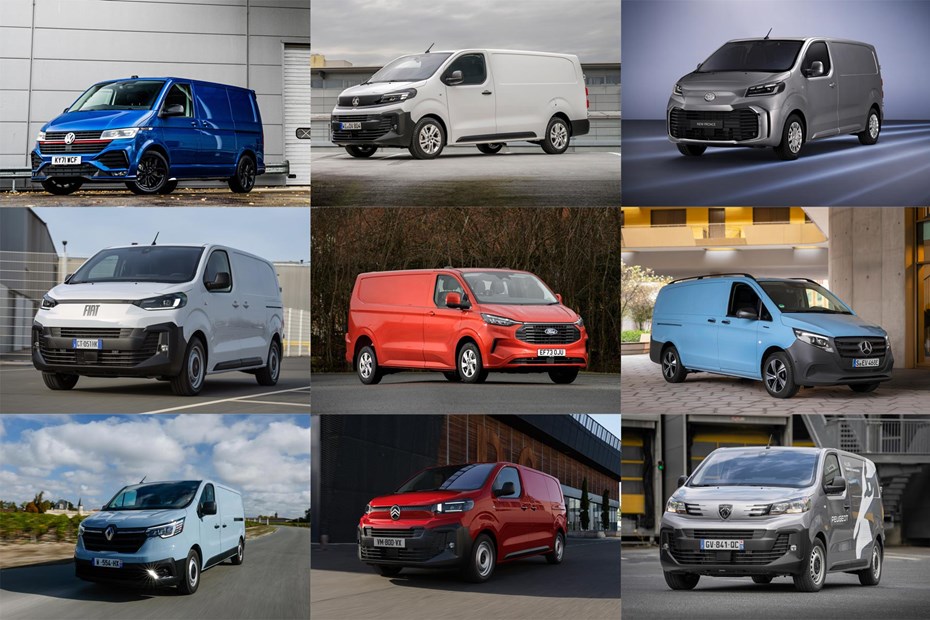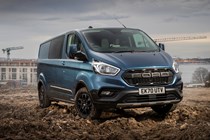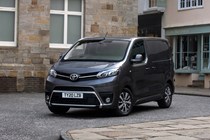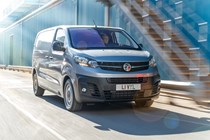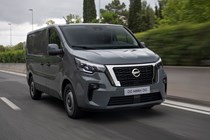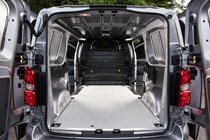The best medium vans are the perfect fit for many businesses. They are small enough to be easy to drive and to fit into and under the various obstacles in town but they are often able to carry as much as some large vans. We’ve driven all of the medium vans on sale in the UK and have used this experience and our expertise to create a definitive top 10 list of the best medium vans on sale right now.
Mid-size vans like these are sometimes referred to as 1.0-tonne models. Typical examples are the Volkswagen Transporter and the Ford Transit Custom, though if you’re looking for a medium work van you’ll also be drawn to the likes of the Mercedes Vito and Renault Trafic. The Vauxhall Vivaro, another big seller, shares a platform with the Citroen Dispatch, Peugeot Expert, Toyota Proace and the Fiat Scudo.
They come in a variety of shapes and sizes, and are also the vans that best bridge the gap between commercial vehicles and lifestyle transport – so if you’re looking for a van to do double duty as a family car, it’s a medium van that usually makes the most sense, particularly if you go for one with two rows of seats.
As well as detailed reviews and dimensions information, Parkers can also lead you to local vans for sale and our partner business mustard.co.uk can help you find van insurance.
Top 10 best medium vans UK 2025
10. Renault Trafic
Best medium van for lengthy loads and a sharp automatic
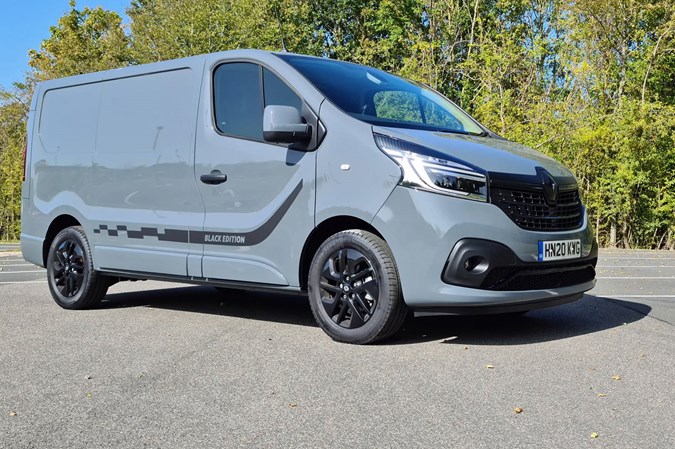

It also shares plenty of components with Renault’s car range, and is pretty nimble to drive. The Renault Pro+ commercial vehicle dealer network is extensive and experienced, too.
As of 2024 there is also the electric Trafic E-Tech, which is a solid if not class-leading addition to the range.
Pros
- Decent safety kit on most recent models
- Excellent automatic gearbox
- Multiple versions to pick from
Cons
- Payload not the best
- Older versions lack safety kit
9. LEVC VN5
Best medium van for hybrid-electric flexibility
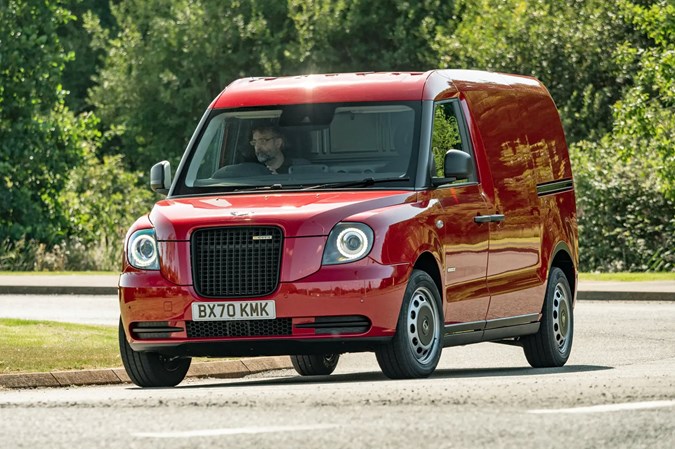

This uses the same petrol-electric plug-in hybrid drivetrain as the taxi, giving the van a 74-mile pure electric range with the added flexibility of then being able to fire up the dinosaur juice and burn a bunch of that in the form of a generator. This allows the VN5 to travel 308 miles without stopping.
The cab is a little tight, but it has a Volvo-grade touchscreen system and digital dials, giving it premium impact. The proportions are unusual; despite appearances it’s larger outside than a Transit Custom but can only carry 5.5 cubic metres of load inside. Pricey, too. But you do get a five-year warranty and durable aluminium / composite construction.
Pros
- The only range-extender van you can buy
- Smart cabin
- Comfortable and good to drive
Cons
- Small for a medium van
- A bit of a left-field choice
8. Mercedes-Benz Vito
Best medium van for a premium interior
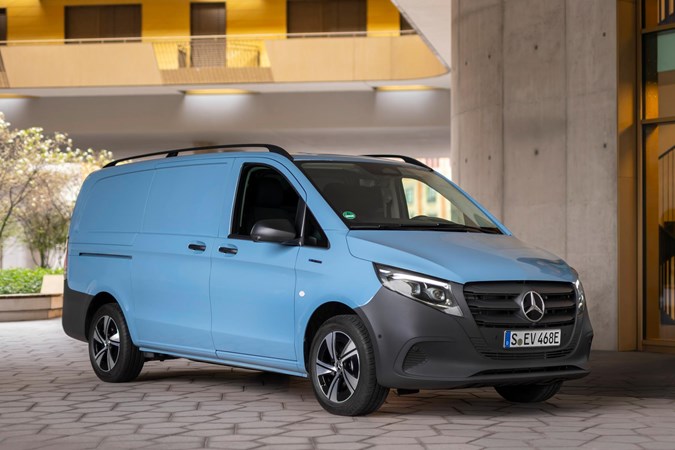

The 2024 update is much more comprehensive than the notably mild 2020 facelift, which barely touched the looks. What is particularly good news is that the latest models all come with a much-needed upgrade to the interior, which now comes with a smart 10.25-inch touchscreen as standard. Sadly you have to go for the higher trim to get the smartphone mirroring that allows you to use your own device as a navigation provider.
These days, all versions in the UK are rear-wheel drive models, although all-wheel drive Vitos are possible, so they might join the range too. Payload isn’t super-generous, having dipped below 1,000kg for all versions. There’s an eVito electric version, too, which is far better thanks to its new bigger battery that offers a range of just under 200 miles.
Pros
- Smart cabin with good tech
- Improved electric version
- Good equipment levels
Cons
- Payload not as good as rivals
- RWD only in the UK
4=. Citroen Dispatch / Fiat Scudo / Peugeot Expert / Vauxhall Vivaro
Best medium van for around town manoeuvrability
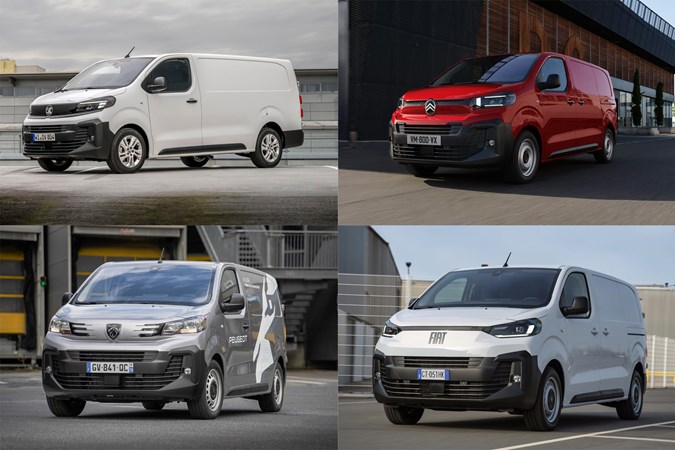

The Vauxhall Vivaro and the Fiat Scudo previously ranked behind the others because they didn't offer the smallest of three lengths, but now the Citroen Dispatch and Peugeot Expert have dropped that option too so none of them do.
This is a very modern medium van with payload ratings around the 1,400kg mark, and excellent fuel economy from its 1.5-litre and 2.0-litre turbodiesel engines – the range has been streamlined in recent times, though, with only two power outputs available. You can get panel vans, crew vans and electric versions of both, but there’s only one roof height. The off-set driving position is a crying shame, too.
Pros
- Strong payload ratings
- Low roof makes urban driving easier
- Impressive diesel engines
Cons
- Poor cabin layout
- Little to differentiate them from one another
3. Toyota Proace
Best medium van for the longest possible warranty
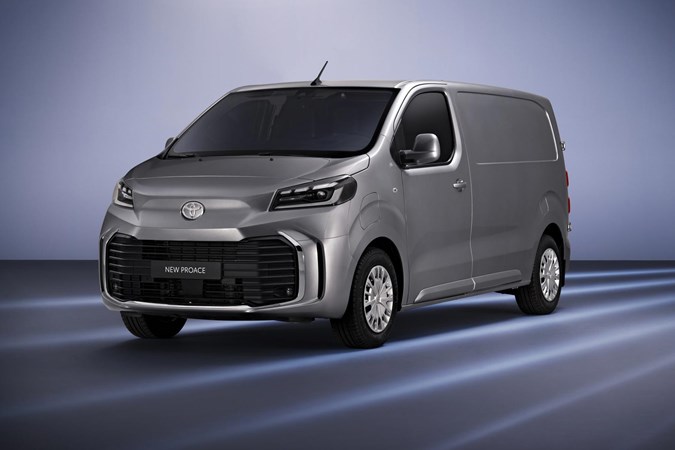

However, Toyota offers this with the lowest entry price and its Relax warranty, which covers you for up to 10 years (including if you buy used). The firm has made a big effort to improve its commercial vehicle dealer network in the UK, too, so you shouldn’t lose out in that area.
Toyota offers the same 120hp 1.5-litre and 145hp 2.0-litre engines but also adds a 180hp version of the 2.0-litre – the latter with standard eight-speed auto. There's the Proace Electric too. There’s plenty of tech for convenience and safety, and more trims than the other four, too, with a Sport model on top of the range. But also still the same crooked driving position.
Pros
- Best-in-class warranty
- Excellent Toyota dealer network
- Multiple trim options
Cons
- Still the same compromised driving position
- Only the one height
2. Volkswagen Transporter
Best medium van for style, comfort and enduring value
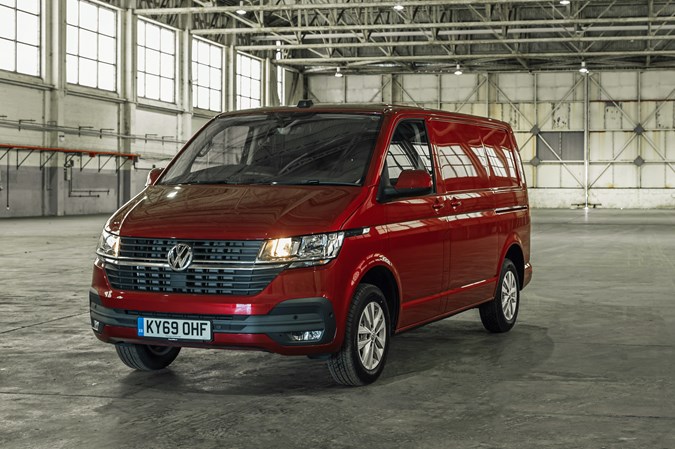

It’s also a great choice if you’re planning to do long-distances, as it’s comfortable and easy to drive – though they can be a little noisy in the cab. The Transporter is also the most reliable medium van according to the annual FN50 survey. The e-Transporter electric version has a disappointingly short range, but was also excellent to drive.
It's not long for this world, though, with the replacement all-new Volkswagen Transporter due out in 2025.
Pros
- Great car-like cabin
- Comfortable to drive
- Strong range of engines
Cons
- Electric version was poor and short-lived
- Soon to be replaced
1. Ford Transit Custom
The UK's best-selling van is even better than before
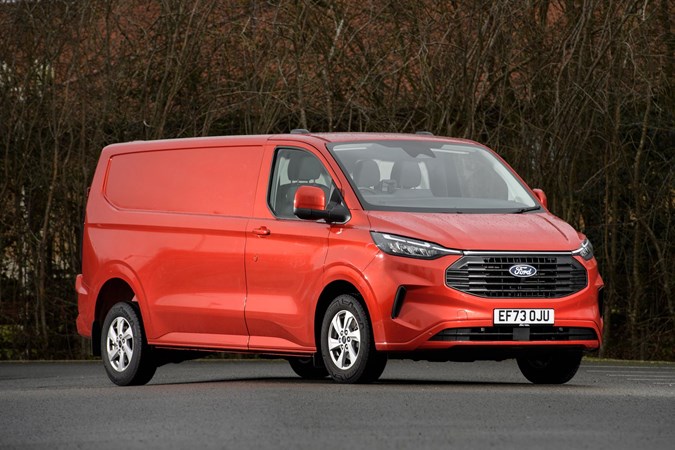

These will tick plenty of the necessary boxes for most people, but there are other versions on the way soon, including an electric and a plug-in hybrid option.
There are some notable but game-changing updates on the latest Transit Custom that have had real thought put into them. The flat floor in the cabin is one, and the L-shaped bulkhead is another.
It's a shame that the cabin now feels a little less light and airy than before, though it is low enough to slot under urban barriers. There is a choice of heights, too, which is a rarity in the medium-van sector.
Pros
- Great van to drive
- Strong diesel engines with more powertrains coming
- Clever touches throughout
Cons
- Payload not as big as some rivals
- Cabin feels a bit claustrophobic
Why buy a medium van?
A medium van offers a good compromise between increased load space – and payload – over a small van while still offering relatively easy parking and a less intimidating driving experience than large vans.
They also work well as crew vans – also known as double cab vans and combi or kombi vans – as even with a second row of seats they still provide a generous load area, much bigger than the boot of any car. It’s for this reason that medium vans are particularly well suited to lifestyle or ‘vanlife’ buyers, as they can carry plenty of people and plenty of gear at the same time.
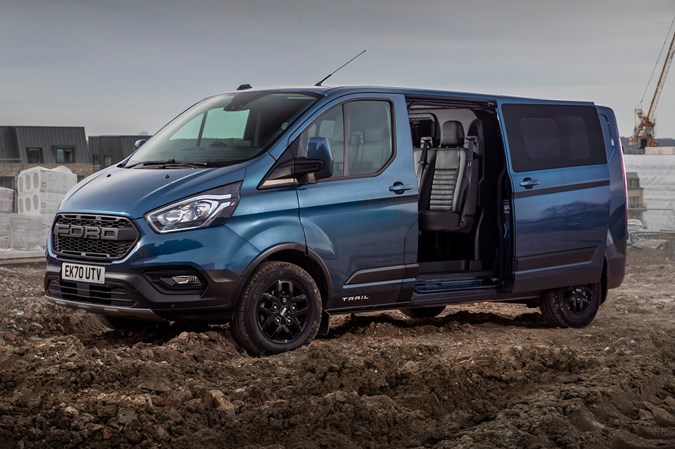
Hence surfers’ traditional love for the VW Transporter family of vans; the Mercedes Vito and especially the Ford Transit Custom have huge enthusiast followings as well.
Most modern mid-size vans offer a driving experience that’s no longer too far removed from a large car or SUV, with a high seating position and good road holding. They will lean a little more round corners, and firm, load-carrying suspension can make them a bit more bumpy, but almost all of the latest high-tech equipment and options you’d expect in car are now available in these vans, too.
This also explains why medium vans are popular for day van and campervan conversions, with factory-backed examples now including not only the VW California but also the Mercedes Marco Polo, Ford Transit Custom Nugget and Vauxhall Vivaro Elite Campervan.

On the negative side, medium van running costs will be higher than with a small van, and large vans can offer much more load space.
Which medium van is best for me?
Medium vans come in a wide variety of types and sizes, from basic working vans with unpainted bumpers and limited standard kit to highly specced near-luxury models. Ford and Volkswagen in particular do a strong range of sport vans with bodykits, large alloy wheels and lowered suspension – check out the latest Transporter Sportline and MS-RT Transit Custom.
While these look good, they will be more susceptible to damage on work sites, reducing their practicality compared with more utilitarian models.

On the other hand, lower-spec vans won’t be as well finished in the back – important if you need to protect your investment from damage when loading – and may be missing curious items such as engine undertrays and wheel arch liners that you would take for granted on a car, let alone creature comforts such as air-conditioning.
Cheaper vans aren’t always nicely trimmed inside the cabin, especially where there’s a second row of seating fitted. Which might be important for your family, as with very upright seat backs and door trim that doesn’t even have armrests, it can feel like you’re putting them in the hold rather than premium economy. The options list can fix these things, but upgrading to the next trim level is often better value.
Safety is another consideration. Check how many airbags come as standard, for example. And although Euro NCAP doesn’t routinely crash-test vans it has begun rating them based on advanced driver assistance systems (ADAS), which has resulted in it singling out a few medium vans that it doesn’t recommend at all.
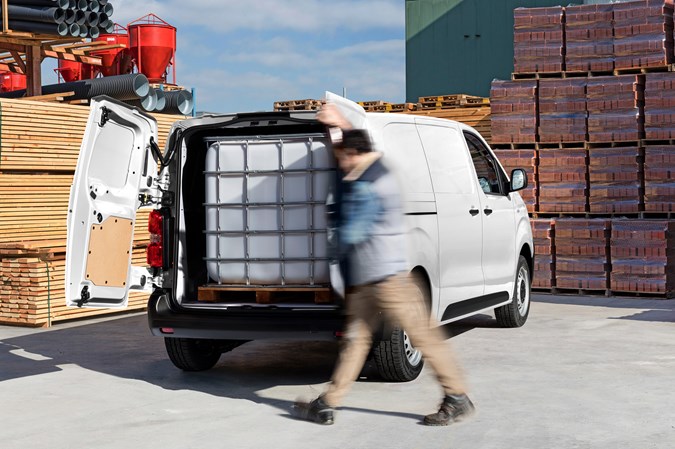
How long do you plan to keep your new van? Most medium vans come with a three-year warranty, but Toyota now offers up to 10 years of cover, and there are several others with five-year warranties now – sometimes you even get extra coverage if you opt for a manufacture finance scheme.
When buying, it’s worth enquiring about service plans, too. These can be very cost-effective and help you better plan your monthly expenses.
What size medium van should I buy?
Beyond the trim level and specification, think about size. Some medium vans come in three body lengths – though a simpler choice between short-wheelbase and long-wheelbase versions (often labelled L1 and L2) is more common. Longer models can carry more in the back. But they will also be more difficult to park.
Most medium vans are sold as low-roof (H1) variants, though some makes do offer high-roof (H2) options; if you want to fit in multistorey car parks, a low roof H1 van is the sensible choice. The Stellantis-built Vauxhall Vivaro, Toyota Proace, Peugeot Expert and Citroen Dispatch are particularly short in stature for this reason.

If you don’t need carpark access but will regularly be rummaging around in the back, a high-roof van may allow you to stand fully upright rather than hunched over.
Payload ratings in the medium panel van sector vary tremendously, so make sure that whatever you choose has the correct payload capacity for what you want to put in it. You can check this on a specific van’s weight plate (usually located under the bonnet), but remember to take any fitted equipment into consideration.
Towing capacity also varies, and can be checked in the same manner.
The dimensions pages attached to our reviews cover all these things in great detail for every medium van.
Diesel, electric or hybrid?
Though VW has dabbled with petrol power in the past, diesel remains the dominant and conventional choice of fuel for a medium van. However, there is an increasing number of 100% electric models to choose from, and some petrol-electric hybrids as well.
Diesel is great for torque and long-distance fuel economy. You can get it anywhere, and it takes mere moments to refuel.
On the other hand, modern diesel engines don’t like short journeys. So if you’re a multidrop driver such as a parcel courier, you may start to have issues with the diesel particulate filter (DPF) if you don’t give the van the chance to clear it out on a longer run once in a while.
We’ve also heard some horror stories about the damage that can be done to high-pressure injection systems by poor quality diesel fuel, so it’s best not to go for the budget supermarket stuff when filling up every time.
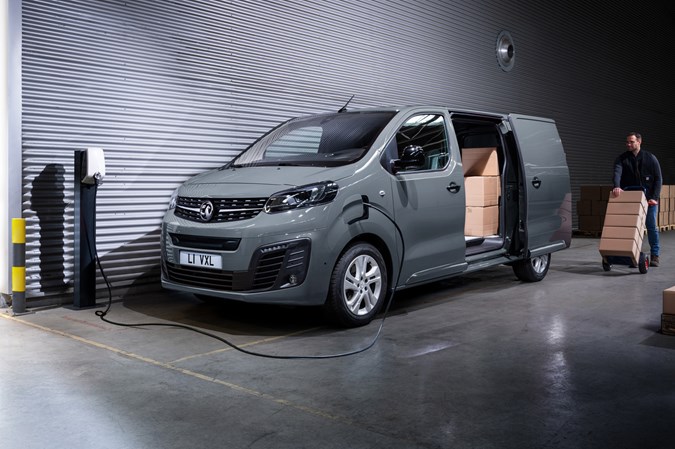
Electric medium vans don’t suffer with this problem, and they can also be super cheap to run in terms of both electricity costs and servicing. But they do bring people out in range anxiety – recharging one is not a short process.
The Stellantis models – e-Dispatch, e-Expert, E-Scudo, Proace Electric and Vivaro Electric – can offer you over 200 miles of claimed driving range per charge now, however, and a very pleasant driving experience that’s quiet and vibration-free with the convenience of an automatic transmission. Great around town, and very responsive.
The eVito has had a welcome update with a bigger battery in 2022, which makes the latest version well worth a look, even if the range, at 162 miles, is not quite as large as the Stellantis quintet but it will be enough for many. In the future, an electric Renault Trafic E-Tech is on the way but many will be waiting for 2023 when the new Ford Transit Custom arrives with a fully electric version.
Splitting the difference are the only current PHEV (plug-in hybrid electric vehicle) alternative, the LEVC VN5. This uses an electric motor to drive the wheels, which is powered by a battery pack or the petrol engine under the bonnet acting as a generator. The Ford Transit Custom PHEV was an option on the previous generation, and the new model will have one too.
Our full guide to hybrid vans covers these in much greater detail, but the advantage to these is a decent chunk of 100% electric driving from the batteries combined with flexible long-distance driving thanks to the petrol engines. The disadvantages include added complexity, poor mpg when using the petrol engine, and cost (more than some pure electric vans).
Most medium vans are front-wheel drive (FWD), which should suit most buyers; there are a couple of rear-wheel drive (RWD) choices, though, and VW sells the Transporter with 4Motion four-wheel drive. A manual gearbox is standard on almost every van of this type, though automatic transmissions are an increasingly common option.
Automatic vans are typically smoother to drive and less hassle in traffic. And while they cost more initially they should also reduce tyre wear and clutch replacement costs.
Just so you know, we may receive a commission or other compensation from the links on this website - read why you should trust us.


